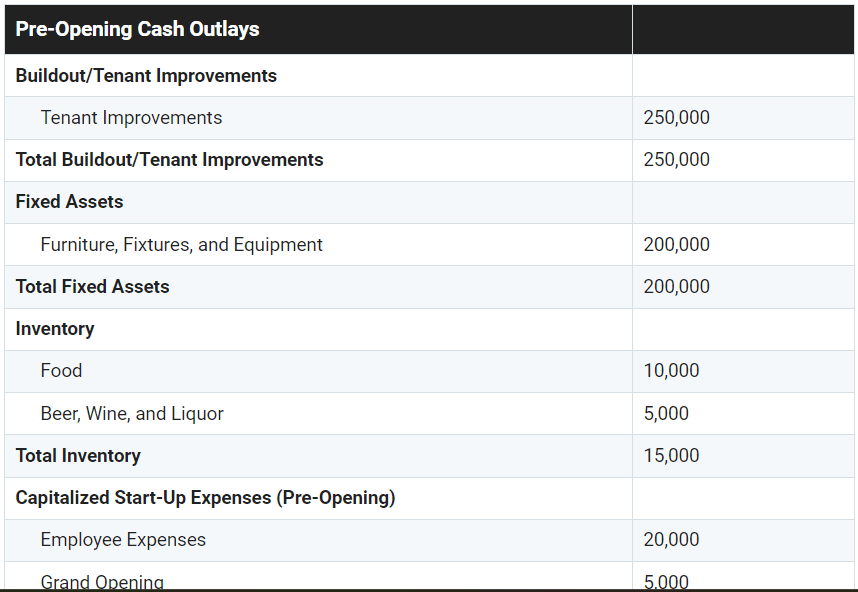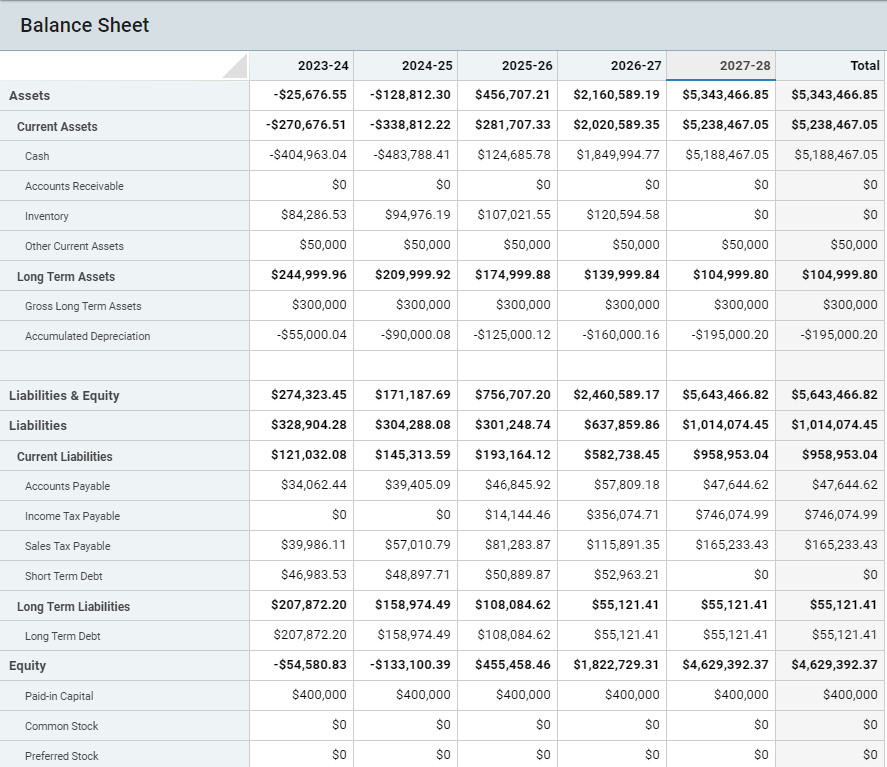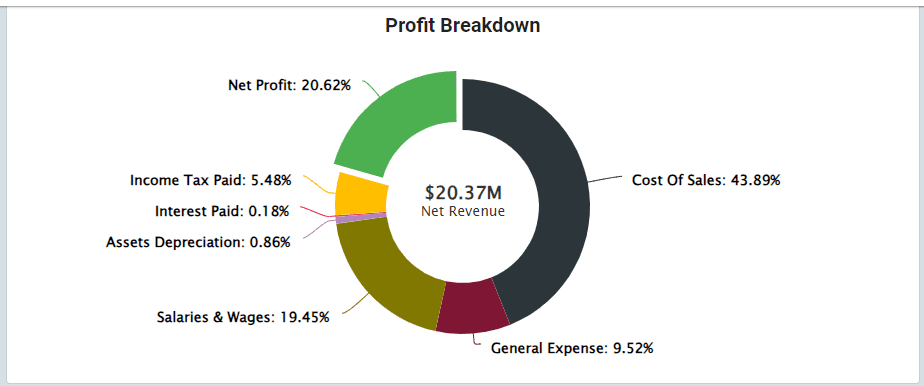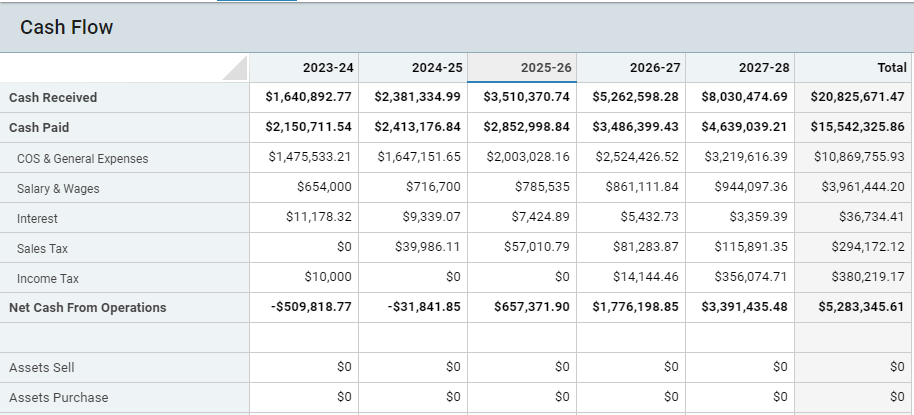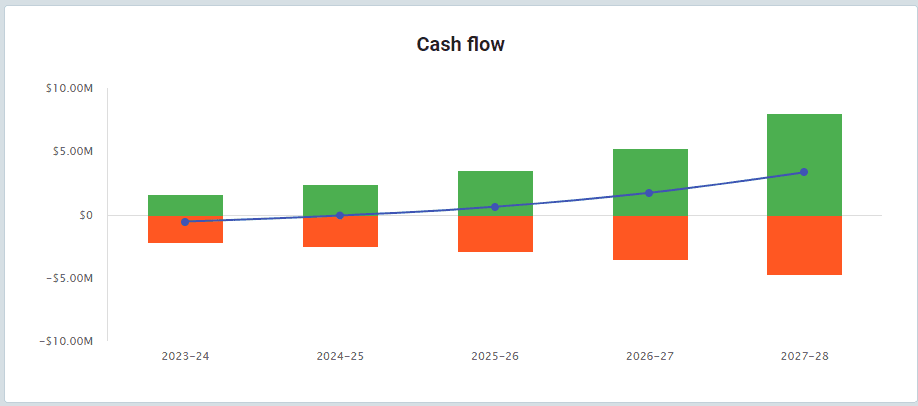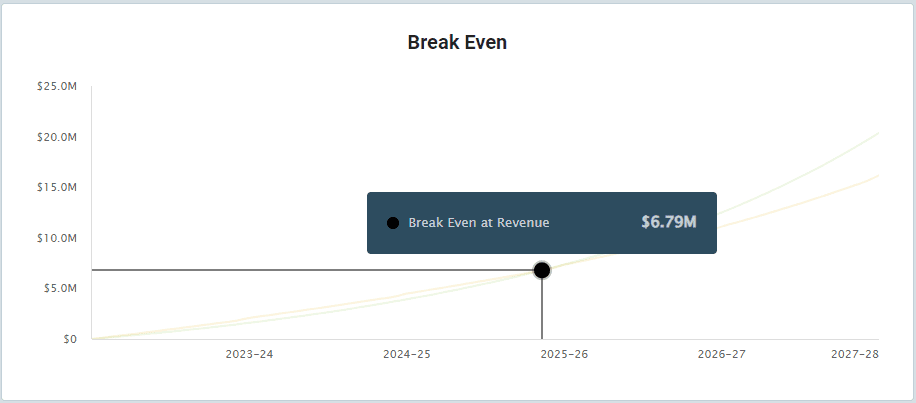400+ Business Plan Examples
Need assistance creating a business plan? Discover Upmetrics’ 400+ free industry-specific real-life business plan examples to help you write your business plan. Upmetrics is a modern and intuitive business plan software that streamlines business planning with its free templates and AI-powered features. So, what are you waiting for? Explore these SBA-approved business plan examples and perfect your plan in no time.
Find your sample business plan
Didn't find what you are looking for?
Writing a business plan from scratch seems like an uphill climb? We get that, but hold tight-you’re not alone. Even business plan writers often feel the same way while writing from scratch. That’s where a little content reference or inspiration can help-just like these business plan examples.
Reading such real-life sample business plans can be incredibly helpful while drafting your very first business plan with zero clue about business plan writing.
As you read and explore these industry-specific examples, you learn more about what you should and should not include in your business plan, ensuring sustainable and long-term growth.
So, let’s explore these 400+ business plan examples to help you quickly write a business plan-hassle-free.
8 Business Plan Examples: Explained section by section
- Executive Summary: A high-level overview of your business plan.
- Company Overview: An in-depth and detailed description of your small business, its fundamental elements, and future goals.
- Market Analysis: A detailed description of your industry with the target market, competitors, and growth potential.
- Products and Services: Description of the products or services you intend to exchange for money.
- Sales and Marketing Strategies: Promotional strategies you will use to attract and retain customers.
- Operations Plan: Business processes and procedures that ensure seamless business operations.
- Management Team: Introduction to your founders, key management, and their compensation plan.
- Financial Plan: A breakdown of your financial projections and financing needs.
This was about the outline. Now let’s break down and understand how to write each section, step by step, with real-life examples.
1. Executive Summary
- Business concept
- Company’s mission
- Company History
- Market Opportunity
- Management Team
- Financial Projections
Executive Summary
Business Concept
East Asian Bistro will be a quick casual dining concept intended to appeal first and foremost to the millennial generation (15-35) and the generations following it. East Asian Bistro will interest Millennials since the food is clean, healthy, economical, and portable.
They’ll be able to get in touch with the restaurant with the identical technology platforms they have learned to use in virtually any part of their lives. East Asian Bistro will appeal to older generations, too but make no mistake; this idea is all about competing and the top in a market that’s changing extremely fast.
Market Opportunity
Though a Smaller portion of the general market than the fast food and casual dining sections, fast-casual concepts are Exploding on the scene and gaining popularity every year. According to Techno Inc. the market research company, the quick-casual segment increased sales by 12 Percent in 2014 and unit count by almost 9 percent.
Management Team
John Doe, the founder and visionary behind the East Asian Bistro notion, has spent his whole career serving excellent meals to hungry customers. He possessed 6 restaurants in San Jose before going into the Phoenix region and producing the East Asian Bistro notion.
Financial Projections & Funding
East Asian Bistro plans to start 4 company-owned restaurants. The first restaurant is Of this sum, $400,000 will be supplied in the shape of equity, with the remainder, $400,000, coming out of a term loan given by a commercial lender.
East Asian Bistro plans to raise $2,000,000 in equity funding. The restaurant Will divide this funding evenly between both business shops. It’s considered that the second, third, and fourth-largest shops will use duration centers from a commercial lender to complete the financing of those shops too. Please be aware that the financial details of the document pertain only to the very first shop.
Once proof of concept has been attained with These shops, East Asian Bistro will proceed to a master business plan with growth programs for other Nevada locations and Then move to cities in other Sunbelt states.
| Year 1 | Year 2 | Year 3 | Year 4 | Year 5 | |
|---|---|---|---|---|---|
| Revenue | 812,451 | 999,871 | 1,455,145 | 1,985,895 | 2,457,878 |
| Cost of sales | 105,104 | 205,451 | 385,451 | 521,451 | 854,145 |
| Employee expense | 312,451 | 351,458 | 452,451 | 482,451 | 492,451 |
| Operating expense | 112,451 | 121,451 | 134,451 | 145,451 | 152,451 |
| EBITDA | 116,451 | 216,451 | 516,451 | 641,451 | 895,452 |
2. Company Overview
As the name suggests, the Company Overview section of your plan provides an overview of your small business, including your business concept, objectives, future goals, and what customers your business serves.
Since you will provide a brief company description in the executive summary, this section will expand on it—providing an in-depth understanding of your business.
Remember, this section is a platform for introducing and positioning your business as an ideal solution for your target market to your reader. So, make sure it’s short and succinct but impactful enough to help them understand what it does, who your potential customers are, and how you can make a difference.
Here are a few key components your business overview must include:
- Company Description
- Mission Statement
- Business Objectives
- Business History
- Future Goals
Here’s an example of a business overview section written for a fictional restaurant brand, East Asian Bistro:
Business Overview
Company Description
East Asian Bistro is a brand new quick-casual Asian-inspired restaurant idea. It’ll be perfectly positioned to benefit from the fastest-growing segment within the food service business and is intended to satisfy the evolving requirements of today’s customers. The menu provides a limited choice of Americanized Asian dishes. It will be limited to approximately 30 items of new and wholesome favorites ready to purchase from China, Japan, Korea, Thailand, the Philippines, and India. It’s anticipated that 65% of Restaurant orders will be consumed off-premises. East Asian Bistro’s pickup system and delivery method will be next to none. The first place will be in San Pedro, San Jose, near the ASU campus, after locations will be seen in other San Pedro places and throughout metropolitan Phoenix. After proof of concept is attained, the idea will be franchised through the Sunbelt states. Since it targets millennials, the restaurant will use the most recent technologies to promote the brand, join with customers, and stay connected. The improvements in online and in-store ordering are made through social networking platforms and digital menu boards.Business Model
The restaurant’s business model will depend upon operational competence and a fantastic-tasting, wholesome menu. The company model is persuasive for the easy reason that from its own large, nicely equipped kitchen, East Asian Bistro will prepare dishes that are available in its restaurant, removed or delivered to be appreciated someplace else or loved in catered events like workplace meetings and birthday celebrations. East Asian Bistro’s inception allows the union of 3 supply factors out of its only kitchen. Again, true differentiation is that delivery of Asian food hasn’t yet been done earlier in metropolitan Phoenix. East Asian Bistro is going to be the very first. The restaurant doesn’t provide terms, so there’s no account receivable. Workers, stock, and operating expenses will be covered from the month in which they are incurred or at the month after the month in which they’re incurred, depending upon payment provisions supplied by suppliers and sellers.Objectives
East Asian Bistro has established the following Goals for the first twelve months of operation Following Launching the restaurant:- Maintain tight control of Operations, Costs, and cash flow through Meticulous Management and Automatic computer control.
- Construct the brand by creating remarkable and memorable guest experiences.
- Build a client base of “regulars” that Won’t let a week go by without a Minimum of One trip to East Asian Bistro.
- Employ a client loyalty program that Will allow East Asian Bistro to advertise directly to its target customers.
Future Goals
East Asian Bistro plans to open 3 restaurants in metropolitan Phoenix in its first 2 decades of operation. Those restaurants will be business owned. When the outlets are open and operating profitably, East Asian Bistro will establish a franchise plan. The plan involves developing master franchisees which will open numerous places in particular geographic areas, starting with the important Arizona markets and moving from there to the north and west.Intellectual Property
The name, East Asian Bistro was registered with the Secretary of State of San Jose. Along with this name, a URL was registered. The proprietor intends to trademark its packaged products. All recipes are owned and proprietary by the Restaurant.3. Market Analysis
Market Analysis is a study of your external business environment, providing a complete overview of your industry and its dynamics. This section provides valuable insights into the market, like what’s working.
When smartly researched, utilized, and written, this section can help you discover and identify untapped areas in the market and strategize to stand out from your competitors.
Remember, this section helps your readers and potential investors understand your target market, market size, and growth potential, so make sure you play your cards right.
Here are a few key components your market analysis section must include:
- Target Market
- Market Size and Growth Potential
- Competitive Analysis
- Market or Industry Trends
- Regulatory Environment
Unlike other sections of your business plan, Market Analysis requires deep research and analytical work. However, using an industry-specific example business plan can save hours of research work.
Consider conducting market research, TAM, SAM, and SOM analysis, and SWOT analysis to get insights for this section.
Here’s an example of a market analysis section written using one of Upmetrics’ sample business plans:
Market Analysis
Industry overview
In 2014, restaurant industry sales reached $752.5 billion, a 4.8% increase over 2013 in current dollars, reflecting a continuing economic recovery. The restaurant industry is predicted to continue to be one of the largest employers in the public sector generating approximately 12.6 million jobs. By 2020 this number is expected to grow to nearly 15 million, indicating that the restaurant and food service industry will continue to thrive.- Restaurant-industry job growth has outpaced the national economy for 12 consecutive years, from 2001 through 2012
- 75 % of adults said they are now trying to eat healthier at restaurants than they did two years ago.
- 71% of adults said they are likelier to visit a restaurant that offers locally produced food items.
- 68% of adults said purchasing meals from restaurants, take-out, and home delivery makes it easier for families with children to manage their day-to-day lives.
Market Size
The US restaurant industry includes about 100K+ stores with combined annual revenue of about $50 billion. Major restaurants include Palm Beach resto, The Continental, Joe’s food court, and Starbucks. The industry is concentrated: the top 50 companies generate more than 70 percent of sales. (First Research)Target Market
The Restaurant’s target customers are, first and foremost, most Millennials (ages 15-35) who live, study, or work in the neighborhood. According to Nicolas Jammet, Co-founder and Co-CEO of Sweetgreen, “they’ve embedded sustainability, charity, and healthy eating into their overall lifestyle. As students, they wanted access to this healthier, cleaner, honest food to eat, and wanted it in an environment that was affordable and convenient.” Other characteristics that describe target customers include:- Really likes the delivery option
- Prefers “honest” food
- Want affordable food
- Environmentally aware
- Like order & pay with a phone
- Embrace speed & convenience
- Appreciates the ability to customize
- Loves ethnic foods
Competitive landscape
Consumer taste and personal income drive demand. The profitability of individual restaurants depends on the ability to secure prime locations, drive store traffic, and deliver high-quality products. Restaurants generally compete with food trucks, coffee shops, quick service, fast food restaurants, gourmet food shops, and donut shops. (First Research)Demographic data
The Restaurant’s first store and in all likelihood, all of its company-owned stores will be in or near Tempe, Arizona. Tempe is located in metropolitan Phoenix and is home to Arizona State University, the largest university in the United States by enrollment.
Source: census.gov
4. Products And Services
The products and services section is where you will mention and elaborate on your product or service range, description, pricing strategies, and more.
Since your business success solely depends on your products or services, your entire plan revolves around this particular section.
This section can be a crucial component of your plan while searching for an investor or partner, as a well-articulated products and services section can help you persuade them.
Here are a few key elements your products and services section must include:
- Product Description
- Product Comparison
- Pricing Strategy
- Order Management
- Quality Measures
Here’s an example of a “products and services” section written using Upmetrics’ professional business plan example:
Product and Services
Sample Menu
Developing the ability to produce and prepare an exciting menu of excellent Asian dishes comes from traveling, tasting, and experiencing Asian meals in Asia. The result is a combination of traditional Asian cuisine with modem gastronomy—with the new flavors of Chinese, Thai, Vietnamese, Southeast Asian, Japanese, and Indian cuisines. Below is a sample menu dishes that Are Certain to be Contained in East Asian Bistro’s menu:Menu Items:

Source: census.gov
The East Asian Bistro marketing manager will purchase food products for meal preparation at local grocery wholesalers, either Costco or United Grocers, using a business account. We will have high-quality Asian staff to prepare the food for our guests. These students will receive a stipend for their work and school credit. The F&B manager will supervise food preparation.
5. Sales And Marketing Strategies
A business’s sales and marketing strategies determine how your product is displayed and reaches your target audience.
A well-designed sales and marketing plan can help you streamline your marketing efforts and create impactful and effective marketing campaigns while keeping track of the marketing budget and maximizing return on investment.
In short, this section will discuss how you’ll acquire new customers using your sales and marketing strategy. You might consider including the following information in your sales and marketing plan:
- Your target audience and brand positioning
- Your business’ UVP
- Marketing channels and distribution tactics you plan to use
- Sales goals and performance measurement
- Your customer retention strategies
- Your sales and marketing goals
Here’s an example of a sales and marketing section written using our traditional business plan template:
Sales and Marketing Strategies
Market Positioning & Brand
Every activity in which the Restaurant participates will establish or reinforce its brand. In doing so, every aspect of the Restaurant’s communications with customers, employees, suppliers, and other partners will support the following branding marketing messages:- East Asian Bistro is a brand that stands for the convergence of healthy, affordable and
- Serve delicious food while utilizing technology to connect with its customers;
- The bistro provides great-tasting food that can be delivered;
- Our food is fast and affordable;
- East Asian Bistro focuses on customer satisfaction.
Marketing Strategies
East Asian Bistro will achieve its marketing objectives through a carefully conceived and aggressively implemented marketing program highlighted by the following strategies:- An innovative, easily navigable website that will attract customers;
- Latest Social Media outlets, including Facebook, Twitter, Pinterest, and Instagram, will begin before opening;
- Ongoing gorilla marketing to the entire neighborhood the week after opening;
- Implementing an online marketing strategy that exemplifies truth, relevance, humanity, passion, originality, and elements of surprise;
- Community outreach through local service organizations, schools, local government, civic organizations, etc.;
- Create customer evangelists who will promote East Asian Bistro through word of mouth.
Sales Strategies
Following are the sales strategies we intend to implement to achieve business success:- Hosting events and collaborating with local businesses and tour companies.
- Rewarding repeat customers through loyalty programs.
- Creating and promoting seasonal menus and offers to attract millennials.
- Offering catering services and private dining options to guests.
- Implementing advanced technologies to gain insights into popular menu items and reduce.
6. Operations Plan
The operations plan section outlines the daily business processes and activities centered on achieving business goals and objectives described in the previous sections of your plan.
A detail-oriented logistics and operations plan helps you and your team define your responsibilities, daily tasks, and short-term goals you need to achieve, keeping track of your long-term objective.
Remember, your logistics and operations plan won’t be static but a living document. You may adjust and update it as time goes on.
Here are a few key elements your operations plan section must include:
- Staffing and training
- Tools and equipment
- Inventory management
- Supply chain management
- Operational process
Here’s an example of a logistics and operations plan section written using Upmetrics’ business plan format:
Restaurant Operations
Staffing and Training
An ongoing training and education program will ensure that each staff member learns and implements East Asian Bistro’s exacting service and operational procedures standards. Staff meetings will reinforce service standards and principles. The Restaurant will have detailed work descriptions and training programs for each position, from entry-level employees to the ongoing development of managers and owners. New employees will undergo an extensive training program. This ensures that each guest receives a quality experience from all employees, regardless of how long they have been employed. The Restaurant embraces the concept of promoting from within. Excellence in one function typically leads to excellence in another. There will be regular staff evaluations and training to ensure motivation and address critical issues.Inventory controls
The founder will be responsible for hiring and training managers who, in turn, will ensure that the day-to-day operations will comply with the standards set by Restaurant policy. Weekly management meetings will provide a forum to review and discuss financial and operational performance. Critical decisions related to purchasing, human resources, marketing, capital expenditures, and customer service will also be addressed.Purchasing cost controls
Food preparation personnel will follow standardized recipes developed by the founders to control food costs and ensure consistency. The Restaurant will offer an innovative menu with nutritious food while achieving the most significant margin yield.Customer Service
The hospitality business recognizes the client’s support experience is the critical driver to replicate business. The direction will Offer a superior degree of Professionalism by hiring individuals who deliver the ideal attitude to work and teaching them the skills required to accommodate guests. The Restaurant will keep high levels of consumer satisfaction with talented, educated, and well-trained workers that understand and implement the fundamentals of fantastic service. Ongoing training will be provided to enable staff to perform their jobs with confidence and ability. Employees are well-spoken, well-versed, and trained to provide friendly, prompt, and professional service to each customer. This practice teaches employees who, by producing an exceptional customer experience, can optimize sales and raise their own reimbursement. The team will have the knowledge and service required to create excellent daily service for every customer.Technology & Software
While the quality of the cuisine and dining experience contributes significantly to a restaurant’s profitability, attention to business and financial details can transform small changes into significant returns. Critical metrics related to sales, cost of sales, labor, inventory, marketing, and overhead are monitored daily. Trends are evaluated, and constructive actions will be taken where improvement is needed. The management team will have access to the restaurant’s transactions and reports available in its real-time POS (point of sale) and accounting systems. Trends will be evaluated, and corrective action will be implemented as required.Read more: How to create a business operations plan
7. Management Team
Your management team plays a crucial role in the ultimate success of your business. And this section introduces your owners and management team, along with their qualifications, industry experience, roles and responsibilities, and compensation plan.
A strong management team section can be critical to weigh authority and help investors be confident about your business idea and vision.
Make sure to include the educational background, accomplishments, work experience, and area of expertise for each individual, part of your management.
You might consider including the following information in the management team section:
- Business owner/founders
- Key management
- Organization structure
- Compensation plan
- Advisors/consultants
Here’s an example of a management team section written using one of Upmetrics’ business plan templates.
Management Team
East Asian Bistro is the vision of a successful businessman who brings several essential skills and experiences to the Company, including:
- A passion for food and delighting customers;
- Well-balanced complementary skills;
- Flexibility and ability to adapt to new and different circumstances;
- Understanding of the importance of consistent and high-quality customer service.
John Doe
Founder & CEO – john@example.com
Mr John was born and raised in Arizona. After graduating from Arizona State University, he joined his family restaurant business and learned all aspects of the company, from taking care of customers to managing a busy kitchen. After selling the five Inchon restaurants, Mr John joined his wife’s family, who had immigrated to metropolitan Phoenix, Arizona. After studying several restaurant concepts, John created East Asian Bistro. He is driven by how the fast-casual idea seems to fit how Americans eat.
Jane Doe
Store Manager – jone@example.com
Reporting to Mr John, the Store Manager will be responsible for the entire operation. In addition to enforcing all policies of the Restaurant as outlined, the Store Manager will oversee daily operations concentrating primarily on ensuring standards are adhered to during all times of the day. She will be responsible for hiring, training, disciplining and terminating service and bar staff, with assistance as needed from the founder.
Compensation Plan
The Company aims to create a successful and rewarding work environment. Mr Doe’ firmly believes that employee satisfaction is pivotal to customer satisfaction. The management team will consist of one General Store Manager and an Assistant Manager. They will be paid $50,000 and $35,000 respectively.
The remaining employees will be hourly. For the first year of operation, no employee benefits will be offered. Down the road, this will be reviewed for ownership desires to provide a benefits program allowing East Asian Bistro to be competitive in the workplace and take care of employees. East Asian Bistro will be staffed as follows:
| Front of House | Starting Month | Count | Annual Salary |
|---|---|---|---|
| Manager | 1st | 2 | 30,000 |
| Serving Staff | 1st | 6 | 9,600 |
| Bartender | 3rd | 1 | 16,000 |
| Dish Washers | 3rd | 4 | 6,400 |
| Back of the House | Starting Month | Count | Annual Salary |
|---|---|---|---|
| Head Cook | 1st | 1 | 24,000 |
| Cooks | 1st | 4 | 20,000 |
| Servents | 1st | 4 | 16,000 |
| Cleaners | 1st | 3 | 8,000 |
8. Financial Plan
It’s no secret that the financial plan is the most crucial yet nerve-wracking aspect of business planning. In fact, it’s one of the deciding factors when it comes to convincing potential investors and banks to invest or lend money.
This section of your plan details your business’s financial information and how it will reach its financial goals. The information may include balance sheet, income, and cash flow statements.
Here are a few key components and financial statements you must include or provide while creating a financial plan:
- Profit and loss statements
- Operating costs
- Income statement
- Cash flow statement
- Balance sheet
- Break-even point
- Financing needs
Here’s an example of a financial plan section created using Upmetrics’ financial forecasting tool.
Financial Plan
Startup Expenditures
The following table highlights how the startup capital will be utilized:ᅠ
Revenue Assumptions
The financial forecast assumes that East Asian Bistro will process an average of 250 customer transactions daily, seven days a week. It further believes that the average food purchase will be $7.00, and the average beverage purchase will be $4.50. Lastly, prices are forecast to grow by 3% per year, whereas the number of transactions is indicated to increase by 5% per year.
Cost of Goods Sold
The forecast assumes that food costs will run at 27% of the food sales price and beverage costs will be 20% of the beverage cost. A 1% factor has been forecast for comps and promotions. COGS is forecast to increase by 3% per year.
Operating Expense Assumptions
The operating expenses that appear in the following income statement forecast are assumed to grow by 3% per year, except for credit card fees, which are based on gross revenue.
Balance Sheet Assumptions
It is assumed that no accounts are receivable as products are paid for at the time of purchase. Charges payable are assumed to be paid for in the month in which they are incurred or in the month following the month they are incurred, depending upon timing and supplier terms. Furniture, fixtures, and equipment are assumed to be depreciated over 72 months. Capitalized startup expenses are amortized over 60 months.
Bank Loan Assumptions
A $300,000 commercial bank loan is assumed to fully amortize over 72 months at an interest rate of 4.00%
Projected Balance Sheet
Following is the projected balance sheet for East Asian Bistro:
Projected Profit and Loss Sheet
Projected Cash flow statement
Break Even Point
9. Appendix
While an Appendix isn’t a required element of your business plan, it can be pretty helpful in adding legal notes, charts, tables, or any other critical information to support your business document.
It generally includes financial statements, information, and documents that didn’t naturally fit into your plan but can be considered critical enough to add.
In addition, it helps readers navigate through the entire business plan and easily find specific information or documents.

Pro-tip
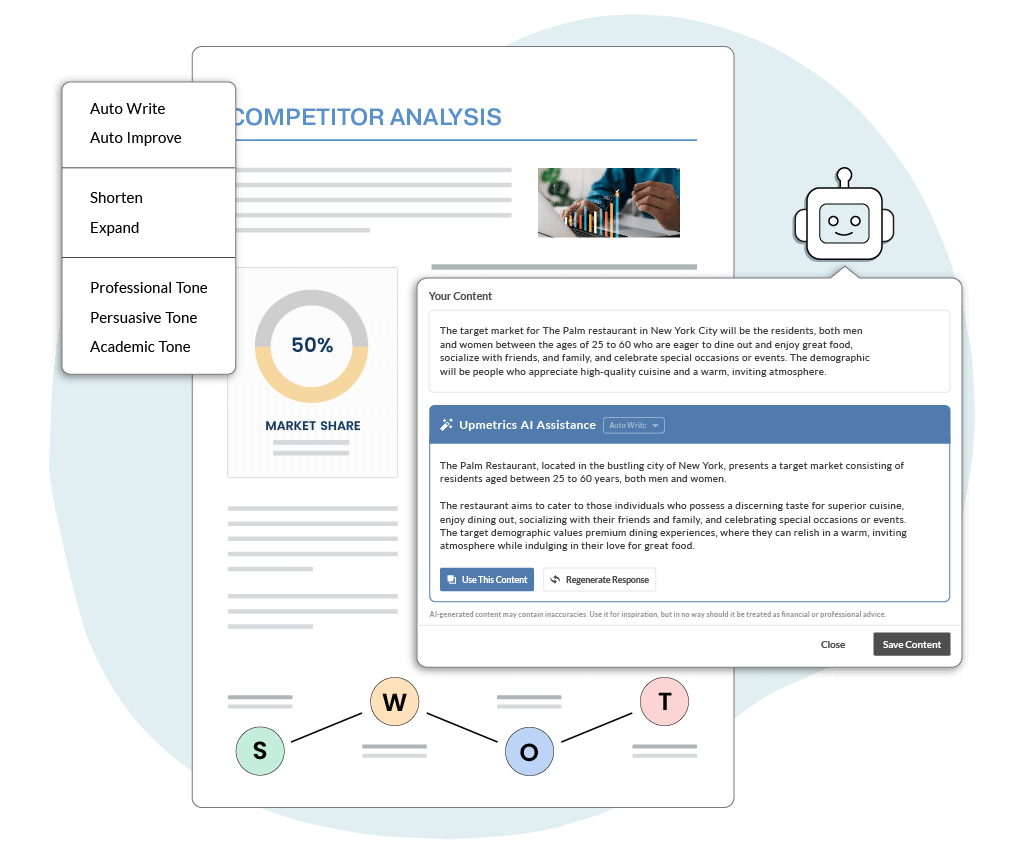
Since we are finished discussing the sections of a business, let’s learn more about how you can put an example business plan to use while writing your own.
How to use an Example of a Business Plan to write your own?
Having real-life and industry-specific business plan examples by your side can be incredibly resourceful to help you write a business plan from scratch.
A well-planned structure helps you outline your plan, while content inspiration helps you set the tone for your business document.
Let’s dive deep and understand how to use these examples effectively to write your business plan.
1. Understanding the Structure
Traditional business plans generally follow a similar structure.
It starts with an executive summary followed by a company description, market analysis, product and services, sales and marketing strategies, operational plan, management team, financial plan, and appendix.
Using an example business plan is the best way to understand the structure and outline your plan.
2. Gaining Inspiration
Reading industry-specific business plan examples can help you gain inspiration for your plan. You can gain insights on presenting your business idea, vision, mission, and values and persuade investors to invest in your idea.
3. Learning Industry-Specific Language
There’s no universal template for business planning that fits all. An industry-specific template can help you learn and understand the business language for your industry and the best way to communicate your message to your investors.
4. Identifying Key Elements
Reading business plan examples of similar businesses can help you identify the key elements and information to include in your plan. You can keep note of these and ensure everything necessary for investors to consider is present in your final draft.
5. Crafting Financial Projections
A financial plan is a critical component of your business plan, and a good business plan example can help you better understand how they project their financials which can be incredibly helpful while forecasting yours.
6. Refining Your Executive Summary
As mentioned earlier, your executive summary is a key factor influencing potential investors and lenders to invest or lend you money. Analyzing free business plan templates can help you optimize your executive summary to make it more brief, persuasive, and attention-grabbing.
7. Realizing What Works and What Doesn’t
Analyzing industry-specific and real-life examples can help you determine what works best and what doesn’t within your industry. Understanding these factors can help you avoid many significant pitfalls.
While business plan examples can be incredibly helpful in writing a plan from scratch, ensure your plan is customized for your business and sends out a unique message. Your business plan must reflect its unique idea, vision, and target market.
Download business plan examples for:
Download a free sample business plan template
Ready to kick-start your business plan writing process? Not sure where to start? Here you go, download our free sample business plan, import data directly into the editor, and start planning.
This intuitive, modern, and investment-ready template is designed specifically for startups and small businesses. In fact, this format has helped 110K+ entrepreneurs create business plans to secure funding, business grants, and loans. It includes a business planning course and step-by-step instructions to write each section.
Business Plan Types: Choose the suitable template
Well, there are a few types of business plans. Though they cover similar categories, they all have different formats intended for different purposes or industries.
Here are a few common business plan types to help you choose the most suitable one for your business:
1. One-page business plan
One page business plan can be considered a one-page version of a standard business plan. It’s mainly used to present a quick overview of small businesses to your vendors, employees, investors, or stakeholders.
Considering its shorter length, creating a one page business plan can be a lot easier and less time-consuming compared to a standard business plan using a business plan software like Upmetrics.
2. Lean business plan
A lean business plan is a summarized version of a standard business plan that is longer than a one-page one. It’s mainly used to track finances and emphasize achieving short-term milestones.
This business plan type is best suitable if you are unsure about the business planning process. Morever, drafting a lean business plan is also a lot easier and faster than a standard one.
3. Traditional business plan
A traditional business plan is the standard plan entrepreneurs have been using for years to outline marketing strategies, project financials, and draw investors. A traditional business plan can be a few dozen to a hundred-page long, depending on its purpose and your business specifications.
A traditional plan is a must-have business document for business owners aiming to achieve long-term business success.
4. Internal business plan
As the name suggests, an internal business plan is a document designed for internal management and team members to ensure everyone’s on the same page. The primary focus of these plans is to set primary goals and outline processes aiming to achieve them—ultimately streamlining business operations.
Start Writing Your Business Plan
There’s no denying—creating a business plan that draws investors in needs some serious work; it’s no stroll in the park. But you must take the first step to stay ahead in the cut-throat competition; there is no way around it.
So, what are you waiting for? Understand your business and the value it offers to its customers, find a suitable template from our library, and start planning.
Simplifying Business Planning through AI-Powered Insights.

Imad Ahmed
Founder, CEO & Lead Scientist at Nanolyse Technologies
After trying Upmetrics, I wish to highly recommend this app to anyone who needs to write a business plan flexibly and to a high standard.
Frequently Asked Questions
How can I write my own business plan?
Follow this step-by-step process to write your business plan on your own.
- Choose a format that best suits your business requirements
- Create a business plan outline
- Create a company description section
- Conduct market research
- Conduct a competitive analysis
- Describe your product and services
- Outline sales and marketing strategies
- Create a logistics and operations plan
- Introduce management team
- Project financials
- Summarize your plan with an executive summary
- Complete your plan with an appendix
Where can I find business plan examples?
Upmetrics is an incredible business planning solution providing 400+ business plan samples and examples. You can easily create a good business plan using these industry-specific templates.
What is a business plan template?
A business plan template is a pre-formatted business plan, usually written for a fictional company. These industry-specific templates can help entrepreneurs understand a business plan’s structure and other key components. These templates are used mainly by entrepreneurs planning to launch a new startup or expand an existing business.
What are the 3Cs of a business plan?
Concept, contents, and cashflow are the 3Cs of a business plan that can be defined as follows:
- Concept: Your concept should explain the purpose of your business, summarizing what you plan to accomplish with this very business.
- Contents: Your content should reflect your concept, product and services, target market, and competition.
- Cashflow: Your cashflow section must detail your cash in-and-out flows, including capital investment, operations costs, and revenue projections.
Why Is It Beneficial to Use a Sample Business Plan as a Guide?
Let’s face it—writing a 40-50 page business plan from scratch can be too intimidating; you may soon give up and won’t even finish it.
Instead, using a sample business plan as a guide can help you understand its structure, gain inspiration and ideas for content, plan marketing strategies, and project financials. In short, using business template examples is the best way to write a business plan.
When should you not follow a business plan example?
We’ve always been saying this, using an example of a business plan is the best way to write one. However, it’s also critical to understand when not to follow a template. Here’s when:
- The format does not align with your business model or industry.
- Include outdated templates and information.
- Offer poorly written content.
- Include misleading and poorly done financials.
- There’s a lack of expertise.
These are a few red flags in a template you must consider looking at while choosing one.
Are these examples suited for business plan beginners?
Absolutely. In fact, these examples are specially designed, keeping common issues faced by beginners while drafting a plan in mind to serve them best. So, if you are a new or an established business with no planning experience, you got to check out these templates.
ᅠ

Looking for a faster way to finish your business plan?
No Risk – Cancel at Any Time – 15 Day Money Back Guarantee


























